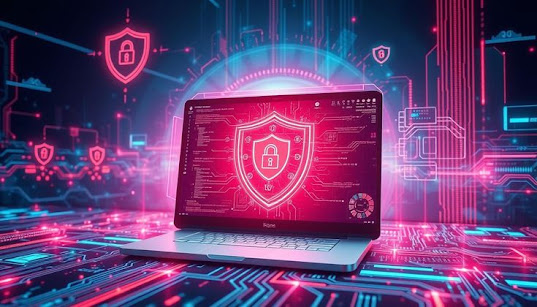The Rise of AI-Powered Cyber Attacks in 2025
The Rise of AI-Powered Cyber Attacks in 2025
Artificial Intelligence is no longer just a buzzword—it's now a powerful tool in the hands of cybercriminals.
1. Introduction: A New Era of Threats
In 2025, cybersecurity has entered a new battlefield. Traditional firewalls and antivirus systems are no match for sophisticated, AI-driven threats that adapt, learn, and exploit faster than ever before. As AI continues to evolve, cybercriminals are using these advancements to their benefit, launching attacks that are highly targeted, faster, and harder to detect.
Cyber threats powered by AI have grown exponentially—transforming from scripted attacks to autonomous decision-making systems.
2. Understanding AI in the Cybercrime Toolkit
AI provides attackers with the ability to:
- Analyze massive datasets to uncover vulnerabilities.
- Craft personalized phishing messages using Natural Language Processing (NLP).
- Deploy polymorphic malware that mutates to avoid detection.
- Automate reconnaissance and target selection.
Machine learning models are being trained on stolen data to mimic human behavior, making threats indistinguishable from legitimate actions.
3. Deepfake Technology and AI-Generated Content
One of the most alarming AI developments in cybercrime is the rise of deepfake technology. Using AI-generated images, voices, and videos, attackers can impersonate CEOs, government officials, or even family members.
In 2025, deepfakes are being used in business email compromise (BEC) scams, voice phishing (vishing), and social engineering attacks that were once considered far-fetched.
Cybercriminals now replicate facial expressions and voice tones with terrifying accuracy—fooling even the most cautious users.
4. Generative AI in Phishing and Scam Campaigns
Phishing attacks have become more persuasive and context-aware. Instead of poorly written messages, users receive emails that read like they were written by a colleague or friend.
These emails may include:
- Hyper-personalized messaging using scraped social media content.
- Embedded malware disguised as resumes, invoices, or documents.
- Fake URLs that mimic real websites with minor alterations.
In 2025, phishing isn’t just social engineering—it’s machine-powered deception at scale.
5. Autonomous Malware and Smart Botnets
Malware has evolved from simple worms to complex, autonomous programs capable of learning from the environment they infect. In 2025, some malware can make decisions based on network behavior and even negotiate ransoms with victims.
AI-controlled botnets can now self-heal, update their attack strategies, and operate without human guidance.
Botnets no longer wait for commands—they act independently, making them incredibly hard to shut down.
6. AI-Powered Attack Case Studies
Case Study 1: The AI CEO Scam
A major European bank was defrauded of $30 million after deepfake audio imitated the voice of the CEO requesting an emergency transfer.
Case Study 2: Auto-Phishing Bot
A bot used by hackers in Asia was found sending over 5,000 customized phishing emails per hour using real user data from LinkedIn and Facebook.
Real-world incidents show that AI-based attacks are no longer rare—they’re the new norm.
7. Defensive Measures Against AI Cyber Threats
To combat these threats, organizations and individuals must evolve their defenses. Key strategies include:
- Implementing AI-based anomaly detection systems.
- Training employees on deepfake and phishing recognition.
- Using multi-factor authentication (MFA) across all devices and accounts.
- Deploying Zero Trust security frameworks.
Fighting AI with AI is no longer optional—it's essential for survival in 2025’s threat landscape.
8. Ethical Concerns and Legal Gaps
As AI-powered attacks grow, so do the ethical challenges. Who is responsible when a machine commits a crime? Legal systems worldwide are struggling to keep pace with technology.
There’s a global lag in laws that can effectively regulate autonomous cyber weapons and deepfake misuse.
9. The Role of Governments and Cybersecurity Alliances
International collaboration is key. In 2025, many countries have begun sharing threat intelligence and coordinating AI-based defense initiatives.
Agencies like INTERPOL and private cybersecurity firms are forming joint task forces to identify and neutralize AI-led threats quickly.
The fight against AI cybercrime must be global—no single nation can handle it alone.
10. Preparing for the Future: What You Can Do Now
Whether you're an individual or part of an organization, preparation is key. Here are some actions you can take immediately:
- Keep software and systems updated regularly.
- Be skeptical of unexpected messages or calls, even if they seem familiar.
- Use AI-assisted security solutions like behavior-based antivirus tools.
- Encrypt sensitive data and back it up securely.
Being proactive is your strongest defense in a world where machines attack at machine speed.
11. Conclusion: AI—A Double-Edged Sword
AI has revolutionized the cybersecurity space—not only by strengthening our defenses but also by empowering attackers. The key to thriving in 2025 is awareness, adaptation, and innovation.
In the battle of AI vs. AI, staying informed, alert, and ahead of the curve is your best shot at security.






Comments
Post a Comment